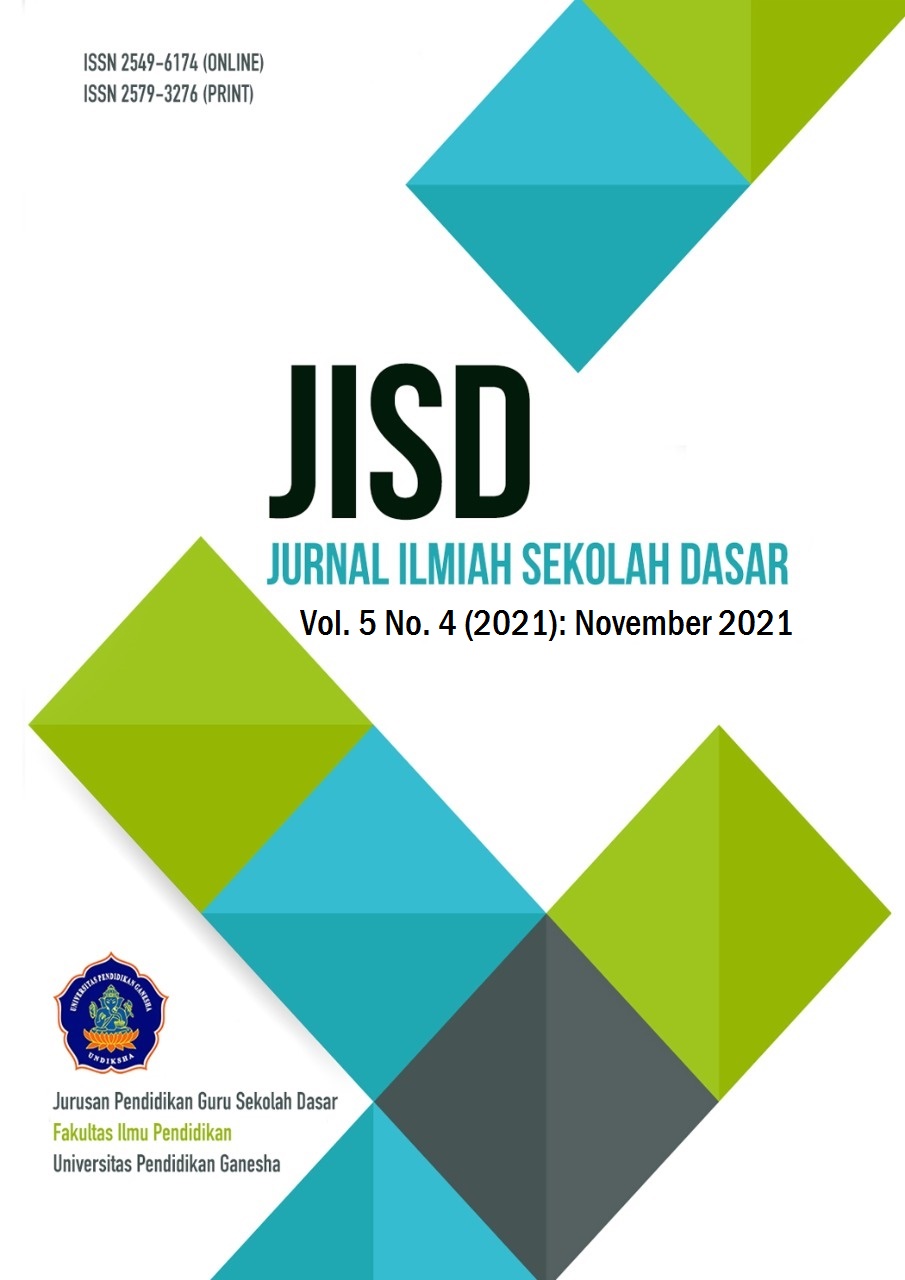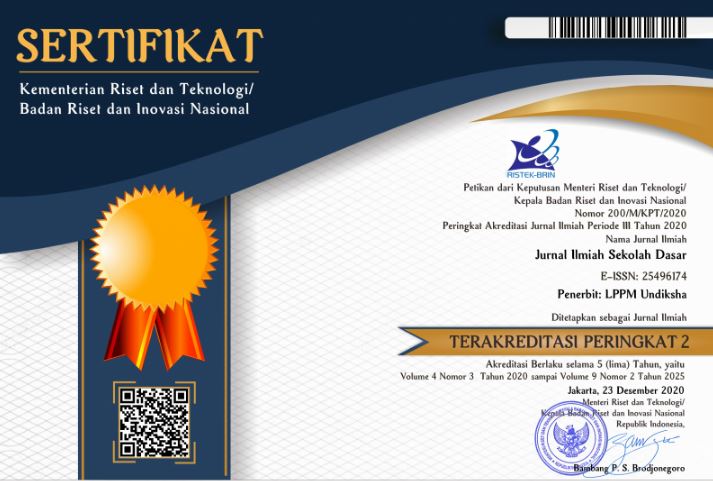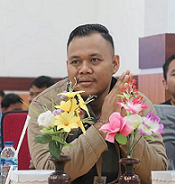Mastery of Science Concepts Improves Scientific Attitude in Elementary School Students
DOI:
https://doi.org/10.23887/jisd.v5i4.37897Keywords:
Scientific Atittude Of Students, Mastery Of Natural Science ConceptsAbstract
Many students have low IPA abilities. Previous research stated that there are still many students who get science learning scores below the average. This study analyzes the relationship between students' scientific attitude and mastery of science concepts in fourth-grade elementary school. This type of research is quantitative research with the correlational method. The research design used is to formulate problems and determine research objectives. The subjects in this study were all students totaling 58 respondents who were taken using the cluster random sampling technique. The method used in this study discusses two variables, the independent variable is students' scientific attitude, and the dependent variable is the mastery of science concepts for grade IV elementary school. The data collection instrument in this study used measurement techniques in 15 formative questions on the dependent variable and 30 questionnaire sheets on the independent variable. Data were analyzed by parametric statistics or product-moment correlation. The results showed differences in the results of students' scientific attitude data with mastery of science concepts. The data showed that tcount was 2,431 > ttable was 1,672 at the significance level = 0.05 with the number of respondents 58 students. Based on these findings, it can be concluded that there is a positive relationship between students' scientific attitudes and mastery of science concepts. Mastery of science concepts can improve students' scientific attitudes.
References
Abendroth, J., & Richter, T. (2021). How to understand what you don’t believe: Metacognitive training prevents belief-biases in multiple text comprehension. Learning and Instruction, 71(August 2020), 101394. https://doi.org/10.1016/j.learninstruc.2020.101394. DOI: https://doi.org/10.1016/j.learninstruc.2020.101394
Anif, S., Sutopo, A., & Prayitno, H. J. (2020). Lesson study validation: Model for social and natural sciences teacher development in the implementation of national curriculum in Muhammadiyah schools, Indonesia. Universal Journal of Educational Research, 8(1), 253–259. https://doi.org/10.13189/ujer.2020.080132. DOI: https://doi.org/10.13189/ujer.2020.080132
Anindyajati, Y. R., & Choiri, A. S. (2017). The effectiveness of using Wordwall Media to increase science-based vocabulary of students with hearing impairment. European Journal of Special Education Research, 2(2), 1–13. https://doi.org/10.5281/zenodo.236877.
Arisantiani, N. K., Putra, M., & Ganing, N. N. (2017). Pengaruh Model Pembelajaran Childrens Learning In Science (Clis) Berbantuan Media Lingkungan Terhadap Kompetensi Pengetahuan IPA. Journal of Education Technology, 1(1). https://doi.org/10.23887/jet.v1i2.11774. DOI: https://doi.org/10.23887/jet.v1i2.11774
Awe, E. Y., & Benge, K. (2017). Hubungan Antara Minat Dan Motivasi Belajar Dengan Hasil Belajar Ipa Pada Siswa Sd. Journal of Education Technology, 1(4), 231. https://doi.org/10.23887/jet.v1i4.12859. DOI: https://doi.org/10.23887/jet.v1i4.12859
Badu, S. Q. (2013). Implementasi Evaluasi Model Kirkpatrick Pada Perkuliahan Masalah Nilai Awal Dan Syarat Batas. Jurnal Penelitian Dan Evaluasi Pendidikan, 16, 102–129. https://doi.org/10.21831/pep.v16i0.1108. DOI: https://doi.org/10.21831/pep.v16i0.1108
Bahari, Darsana, & Putra. (2018). Pengaruh Model Discovery Learning Berbantuan Media Lingkungan Alam Sekitar terhadap Hasil Belajar IPA. Jurnal Ilmiah Sekolah Dasar, 2(2). https://doi.org/10.23887/jisd.v2i2.15488. DOI: https://doi.org/10.23887/jisd.v2i2.15488
Changwong, K., Sukkamart, A., & Sisan, B. (2018). Critical thinking skill development: Analysis of a new learning management model for Thai high schools. Journal of International Studies, 11(2), 37–48. https://doi.org/10.14254/2071. DOI: https://doi.org/10.14254/2071-8330.2018/11-2/3
Darmaji, D., Kurniawan, D. A., Astalini, A., Kurniawan, W., Anwar, K., & Lumbantoruan, A. (2019). Students’ perceptions of electronic’s module in physics practicum. Journal of Education and Learning (EduLearn), 13(2), 288–294. https://doi.org/10.11591/edulearn.v13i2.13005. DOI: https://doi.org/10.11591/edulearn.v13i2.13005
Dewi, Semara, & Putra. (2013). Pengaruh Model Pembelajaran Siklus Belajar “(Learning Cycle)” 5E terhadap Hasil Belajar IPA Siswa Kelas V SDN 26 Pemecutan Denpasar Barat. Mimbar PGSD Undiksha, 2(1), 1–13. https://doi.org/10.23887/jjpgsd.v1i1.1207.
Dwi Lestari, H., & Putu Parmiti, D. P. P. (2020). Pengembangan E-Modul IPA Bermuatan Tes Online Untuk Meningkatkan Hasil Belajar. Journal of Education Technology, 4(1), 73. https://doi.org/10.23887/jet.v4i1.24095. DOI: https://doi.org/10.23887/jet.v4i1.24095
Fartina, Hizbi, T., & Syahidi, K. (2019). Development of Interactive Physics Learning Media Macromedia Flash 8 Based on Straight Motion Material. Journal of Physics: Conference Series, 1539(1). https://doi.org/10.1088/1742-6596/1539/1/012023. DOI: https://doi.org/10.1088/1742-6596/1539/1/012023
Fu, Q.-K., Lin, C.-J., Hwang, G.-J., & Zhang, L. (2019). Impacts of a mind mapping-based contextual gaming approach on EFL students’ writing performance, learning perceptions and generative uses in an English course. Computers & Education, 137. https://doi.org/10.1016/j.compedu.2019.04.005. DOI: https://doi.org/10.1016/j.compedu.2019.04.005
Handayani, N. M. D., Ganing, N. N., & Suniasih, N. W. (2017). Model Pembelajaran Picture and Picture Berbantuan Media Audio-Visual Terhadap Pengetahuan IPA. Journal of Education Technology, 1(3), 176. https://doi.org/10.23887/jet.v1i3.12502. DOI: https://doi.org/10.23887/jet.v1i3.12502
Hanif, M. (2020). The development and effectiveness of motion graphic animation videos to improve primary school students’ sciences learning outcomes. International Journal of Instruction, 13(4), 247–266. https://doi.org/10.29333/iji.2020.13416a. DOI: https://doi.org/10.29333/iji.2020.13416a
Hwang, G. J., Wu, P. H., & Chen, C. C. (2012). An online game approach for improving students’ learning performance in web-based problem-solving activities. Computers and Education, 59(4), 1246–1256. https://doi.org/10.1016/j.compedu.2012.05.009. DOI: https://doi.org/10.1016/j.compedu.2012.05.009
Irwansyah, F. S., Lubab, I., Farida, I., & Ramdhani, M. A. (2017). Designing Interactive Electronic Module in Chemistry Lessons. Journal of Physics: Conference Series, 895(1). https://doi.org/10.1088/1742-6596/895/1/012009. DOI: https://doi.org/10.1088/1742-6596/895/1/012009
Jatmiko, A., Kartina, Y., Irwandani, I., Fakhri, J., Pricilia, A., & Rahayu, T. (2018). Reading Concept Map-Think Pair Share (Remap-TPS) Learning Model on Cognitive Ability and Scientific Attitude. Jurnal Keguruan Dan Ilmu Tarbiyah, 3(2). https://doi.org/10.24042/tadris.v3i2.3184. DOI: https://doi.org/10.24042/tadris.v3i2.3184
Lai, A., A. F., C., & Lee, G. Y. (2019). An augmented reality-based learning approach to enhancing students’ science reading performances from the perspective of the cognitive load theory. British Journal of Educational Technology, 50(1), 232–247. https://doi.org/10.1111/bjet.12716. DOI: https://doi.org/10.1111/bjet.12716
Latipah, E., Kistoro, H. C. A., & Khairunnisa, I. (2020). Scientific Attitudes in Islamic Education Learning: Relationship and the Role of Self-Efficacy and Social Support. Edukasia : Jurnal Penelitian Pendidikan Islam. https://doi.org/10.21043/edukasia.v15i1.7364. DOI: https://doi.org/10.21043/edukasia.v15i1.7364
Lee, S., & Kim, S. H. (2018). Scientific Knowledge and Attitudes Toward Science in South Korea: Does Knowledge Lead to Favorable Attitudes? Science Communication, 40(2), 147–172. https://doi.org/10.1177/1075547017753189. DOI: https://doi.org/10.1177/1075547017753189
Lukman, A., Hayati, D. K., & Hakim, N. (2019). Pengembangan Video Animasi Berbasis Kearifan Lokal pada Pembelajaran IPA Kelas V di Sekolah Dasar. Elementary: Jurnal Ilmiah Pendidikan Dasar, 5(2), 153. https://doi.org/10.32332/elementary.v5i2.1750. DOI: https://doi.org/10.32332/elementary.v5i2.1750
Maijarern, T., Chaiwut, N., & Nobnop, R. (2018). Augmented reality for science instructional media in primary school. 3rd International Conference on Digital Arts, Media and Technology, ICDAMT. https://doi.org/10.1109/ICDAMT.2018.8376523. DOI: https://doi.org/10.1109/ICDAMT.2018.8376523
Maison, M., Haryanto, H., Ernawati, M. D. W., Ningsih, Y., Jannah, N., Puspitasari, T. O., & Putra, D. S. (2020). Comparison of student attitudes towards natural sciences. International Journal of Evaluation and Research in Education, 9(1), 54–61. https://doi.org/10.11591/ijere.v9i1.20394. DOI: https://doi.org/10.11591/ijere.v9i1.20394
Marisda, D. H., & Handayani, Y. (2020). Model Pembelajaran Kolaboratif Berbasis Tugas Sebagai Alternatif Pembelajaran Fisika Matematika. Fisika PPs UNM, 2(1), 9–12. DOI: https://doi.org/10.24252/jpf.v9i2.14582
Muhammad, H. M. (2018). Keefektifan Model Pembelajaran Tebak Kata Terhadap Hasil Belajar Pada Tema 7 “Indahnya Keragaman Di Negeriku” Siswa Kelas Iv. Mimbar Ilmu, 23(3), 200–207. https://doi.org/10.23887/mi.v23i3.16436. DOI: https://doi.org/10.23887/mi.v23i3.16436
Narayani, W. (2019). Pengaruh Model Pembelajaran Nht Berbasis Tri Hita Karana Terhadap Karakter Dan Hasil Belajar IPA. Jurnal Pendidikan Multikultural Indonesia., 2(1). https://doi.org/10.23887/jpmu.v2i1.20785. DOI: https://doi.org/10.23887/jpmu.v2i1.20785
Novika Auliyana, S., Akbar, S., & Yuniastuti. (2018). Penerapan Pembelajaran Tematik Terpadu di Sekolah Dasar. Jurnal Pendidikan: Teori, Penelitian, Dan Pengembangan, 3(12), 1572–1582. https://doi.org/10.17977/jptpp.v3i12.11796.
Permana, E. P., & Nourmavita, D. (2017). Pengembangan Multimedia Interaktif Pada Mata Pelajaran Ipa Materi Mendeskripsikan Daur Hidup Hewan Di Lingkungan Sekitar Siswa Kelas Iv Sekolah Dasar. Jurnal PGSD, 10(2), 79–85. https://doi.org/10.33369/pgsd.10.2.79-85. DOI: https://doi.org/10.33369/pgsd.10.2.79-85
Rahayuningsih, S. (2020). Animation media of animal husbandry thematic science learning to stimulate scientific attitude in early childhood. International Journal of Scientific and Technology Research. https://doi.org/10.23887/jet.v3i1.17959 Article Metrics.
Rosalina, S. S., & Suhardi, A. (2020). Need Analysis of Interactive Multimedia Development With Contextual Approach on Pollution Material. INSECTA: Integrative Science Education and Teaching Activity Journal, 1(1), 93. https://doi.org/10.21154/insecta.v1i1.2107. DOI: https://doi.org/10.21154/insecta.v1i1.2107
Rubini, B., Permanasari, A., & Yuningsih, W. (2018). Learning Multimedia Based on Science Literacy on the Lightning Theme. Jurnal Penelitian Dan Pembelajaran IPA, 4(2), 89–104. https://doi.org/10.30870/jppi.v4i2.3926. DOI: https://doi.org/10.30870/jppi.v4i2.3926
Rusli, R., Rahman, A., & Abdullah, H. (2020). Student perception data on online learning using heutagogy approach in the Faculty of Mathematics and Natural Sciences of Universitas Negeri Makassar, Indonesia. Data in Brief, 29, 105152. https://doi.org/10.1016/j.dib.2020.105152. DOI: https://doi.org/10.1016/j.dib.2020.105152
Sakliressy, M. T., Sunarno, W., & Nurosyid, F. (2021). Students Scientific Attitude in Learning Physics Using Problem Based Learning Model with Experimental and Project Methods. Jurnal Ilmiah Pendidikan Fisika Al-Biruni. https://doi.org/10.24042/jipfalbiruni.v10i1.8347. DOI: https://doi.org/10.24042/jipfalbiruni.v10i1.8347
Santiasih, N. I., Marhaeni, A. A. I. N., & Tika, I. N. (2013). Pengaruh Model Pembelajaran Inkuiri Terbimbing Terhadap Sikap Ilmiah dan Hasil Belajar IPA Siswa Kelas V SD No. 1 Kerobokan Kecamatan Kuta Utara Kabupaten Badung Tahun Pelajaran 2013/2014. Jurnal Pendidikan Dasar Ganesha, 3(1). https://doi.org/10.23887/jet.v3i1.17959 Article Metrics.
Saripudin, E., Sari, I. J., & Mukhtar, M. (2018). Using Macro Flash Animation Media on Motion Material to Improve Learning Achievement for Learning Science in Junior High School. Jurnal Penelitian Dan Pembelajaran IPA, 4(1), 68–75. https://doi.org/10.30870/jppi.v4i1.3316. DOI: https://doi.org/10.30870/jppi.v4i1.3316
Seruni, R., Munawaroh, S., Kurniadewi, F., & Nurjayadi, M. (2020). Implementation of e-module flip PDF professional to improve students’ critical thinking skills through problem based learning. Journal of Physics: Conference Series, 1521(4), 1–6. https://doi.org/10.1088/1742-6596/1521/4/042085. DOI: https://doi.org/10.1088/1742-6596/1521/4/042085
Sintema, E. J. (2020). Effect of COVID-19 on the performance of grade 12 students: Implications for STEM education. Eurasia Journal of Mathematics, Science and Technology Education, 16(7), 1–6. https://doi.org/10.29333/EJMSTE/7893. DOI: https://doi.org/10.29333/ejmste/7893
Subali, B., Kumaidi, Aminah, N. S., & Sumintono, B. (2019). Student achievement based on the use of scientific method in the natural science subject in elementary school. Jurnal Pendidikan IPA Indonesia, 8(1), 39–51. https://doi.org/10.15294/jpii.v8i1.16010. DOI: https://doi.org/10.15294/jpii.v8i1.16010
Suryani, N. K., Renda, N. T., & Wibawa, I. M. C. (2019). Pengaruh Pendekatan Saintifik Berorientasi Tri Kaya Parisudha Terhadap Penguasaan Konsep Ipa Dan Keterampilan Proses Sains Siswa Kelas V Sd Di Gugus Vii Kecamatan Sukasada Kabupaten Buleleng Tahun Pelajaran 2018/2019. Journal of Education Technology. https://doi.org/10.23887/jet.v3i1.17962. DOI: https://doi.org/10.23887/jet.v3i1.17962
Suryawati, E., & Osman, K. (2018). Contextual learning: Innovative approach towards the development of students’ scientific attitude and natural science performance. Eurasia Journal of Mathematics, Science and Technology Education, 14(1), 61–76. https://doi.org/10.12973/ejmste/79329. DOI: https://doi.org/10.12973/ejmste/79329
Syahputra, Y. S., Santosa, R., & Supriyadi, S. (2017). Teacher’S Willingness Towards the Implementation of Scientific Approach: From Theory To Implementation. Journal of English Education, 2(2), 132–137. https://doi.org/10.31327/jee.v2i2.409. DOI: https://doi.org/10.31327/jee.v2i2.409
Töman, U. (2017). Investigation to improve the process of pre-service teachers’ reflective thinking skills through an action research. Universal Journal of Educational Research, 5(9), 1535–1548. https://doi.org/10.13189/ujer.2017.050911. DOI: https://doi.org/10.13189/ujer.2017.050911
Utomo, A. C., Abidin, Z., & Rigiyanti, H. A. (2020). Keefektifan Pembelajaran Project Based Learning Terhadap Sikap Ilmiah Pada Mahasiswa PGSD. Educational Journal of Bhayangkara. https://doi.org/10.31599/edukarya.v1i1.103. DOI: https://doi.org/10.31599/edukarya.v1i1.103
Widani, N. K. T., Sudana, D. N., & Agustiana, I. G. A. T. (2019). Pengaruh Model Pembelajaran Inkuiri Terbimbing Terhadap Hasil Belajar IPA Dan Sikap Ilmiah Pada Siswa Kelas V SD Gugus I Kecamatan Nusa Penida. Journal of Education Technology, 3(1), 15–21. https://doi.org/10.23887/jet.v3i1.17959. DOI: https://doi.org/10.23887/jet.v3i1.17959
Widiartini, P. D. O., Made Putra, M. P., & Manuaba, I. B. S. (2019). Pengaruh Model Pembelajaran Group Investigation Berbasis Tri Hita Karana Terhadap Kompetensi Pengetahuan IPA. Jurnal Ilmiah Sekolah Dasar. https://doi.org/10.23887/jisd.v3i3.19476. DOI: https://doi.org/10.23887/jisd.v3i3.19476
Yunanto, A. A., Herumurti, D., Rochimah, S., & Kuswardayan, I. (2019). English Education Game using Non-Player Character Based on Natural Language Processing. Procedia Computer Science, 1. https://doi.org/10.1016/j.procs.2019.11.158. DOI: https://doi.org/10.1016/j.procs.2019.11.158
Zabolotniaia, M., Cheng, Z., Dorozhkin, E., & Lyzhin, A. (2020). Use of the LMS Moodle for an Effective Implementation of an Innovative Policy in Higher Educational Institutions. International Journal of Emerging Technologies in Learning (IJET), 15(13), 172. https://doi.org/10.3991/ijet.v15i13.14945. DOI: https://doi.org/10.3991/ijet.v15i13.14945
Downloads
Published
How to Cite
Issue
Section
License
Authors who publish with the Journal Ilmiah Sekolah Dasar agree to the following terms:
- Authors retain copyright and grant the journal the right of first publication with the work simultaneously licensed under a Creative Commons Attribution License (CC BY-SA 4.0) that allows others to share the work with an acknowledgment of the work's authorship and initial publication in this journal.
- Authors are able to enter into separate, additional contractual arrangements for the non-exclusive distribution of the journal's published version of the work (e.g., post it to an institutional repository or publish it in a book), with an acknowledgment of its initial publication in this journal.
- Authors are permitted and encouraged to post their work online (e.g., in institutional repositories or on their website) prior to and during the submission process, as it can lead to productive exchanges, as well as earlier and greater citation of published work. (See The Effect of Open Access)










